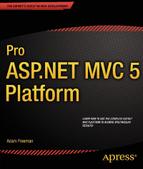Contents
![]() Chapter 1: Putting the ASP.NET Platform in Context
Chapter 1: Putting the ASP.NET Platform in Context
What’s the Structure of This Book?
Part 2: The ASP.NET Platform Foundation
Where Can You Get the Example Code?
What Software Do You Need for This Book?
![]() Chapter 2: Pattern and Tools Primer
Chapter 2: Pattern and Tools Primer
Understanding the Benefits of the MVC Pattern
Adding Packages to the Project
![]() Part 2: The ASP.NET Platform Foundation
Part 2: The ASP.NET Platform Foundation
![]() Chapter 3: The ASP.NET Life Cycles
Chapter 3: The ASP.NET Life Cycles
The ASP.NET Application Life Cycle
Understanding the Application Life Cycle
Receiving Notifications When the Application Starts and Ends
Testing the Start and Stop Notifications
The ASP.NET Request Life Cycle
Understanding the Request Life Cycle
Understanding Modules and Handlers
Handling Request Life-Cycle Events Using Special Methods
Handling Request Life-Cycle Events Without Special Methods
Understanding the ASP.NET Context Objects
Working with HttpApplication Objects
Working with HttpRequest Objects
Working with HttpResponse Objects
Creating Self-registering Modules
Creating the Registration Class
Understanding the Built-in Modules
Adding the System.Net.Http Assembly
Understanding Handlers in the Request Life Cycle
Handlers and the Life-Cycle Events
Registering a Handler Using URL Routing
Registering a Handler Using the Configuration File
Creating Asynchronous Handlers
Creating Modules That Provide Services to Handlers
Controlling Handler Instantiation
Selecting Handlers Dynamically
![]() Chapter 6: Disrupting the Request Life Cycle
Chapter 6: Disrupting the Request Life Cycle
Testing the Example Application
Understanding the Normal Redirection Process
Simplifying the Redirection Process
Transferring a Request to a Different Handler
Avoiding Brittle Application Components
![]() Chapter 7: Detecting Device Capabilities
Chapter 7: Detecting Device Capabilities
Creating a Custom Browser File
Creating a Capability Provider
Using Third-Party Capabilities Data
Avoiding the Capabilities Trap
Tailoring Content to Match Devices
Responding to the Logging Events
Adding Trace Messages to Glimpse
![]() Part 3: The ASP.NET Platform Services
Part 3: The ASP.NET Platform Services
Understanding the Configuration Hierarchy
Working with Basic Configuration Data
Creating a Simple Configuration Section
Creating a Collection Configuration Section
Overriding Configuration Settings
Navigating the ASP.NET Configuration Elements
Understanding the Synchronization Effect
Sessions and Session State Data
Understanding How Sessions Work
Understanding the Synchronization Effect
Configuring Sessions and Session State
Tracking Sessions Without Cookies
Adding the System.Net.Http Assembly
Using Absolute Time Expiration
Using Sliding Time Expirations
Specifying Scavenging Prioritization
Depending on Another Cached Item
Creating Aggregate Dependencies
Receiving Dependency Notifications
Using Notifications to Prevent Cache Ejection
Using the Content Caching Attribute
Controlling the Cache Location
Dynamically Setting Cache Policy
![]() Chapter 13: Getting Started with Identity
Chapter 13: Getting Started with Identity
Creating the ASP.NET Identity Database
Creating the Entity Framework Classes
Completing the Administration Features
Implementing the Delete Feature
![]() Chapter 14: Applying ASP.NET Identity
Chapter 14: Applying ASP.NET Identity
Understanding the Authentication/Authorization Process
Preparing to Implement Authentication
![]() Chapter 15: Advanced ASP.NET Identity
Chapter 15: Advanced ASP.NET Identity
Preparing for Database Migration
Defining an Additional Property
Authorizing Access Using Claims
Using Third-Party Authentication
